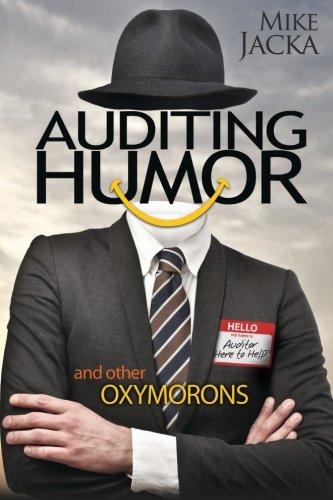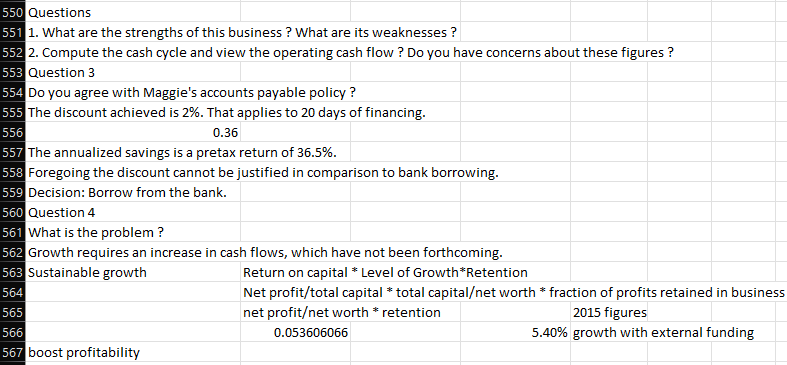

^^^^^^^^^^^^^^^^^^^^^^^^^^^^^^^^^^^^^^^^^^^^^^^^^^^^^^^^^^^^^^^^^^^^^^^^^^^^^^^^^^^^^^^^^^^^^^^^^
Please answer the instructions above based on the case below, thank you for your help.
(Answer will be scanned, including other Chegg answers, thumbs down for plagiarism)
__________________________________________________________________________________
CASE 8
Bob Brown hummed along to a seasonal carol on the van radio as he made his way over the dark and icy roads of Amherst County, Virginia. He and his crew had just finished securing their nursery against some unexpected chilly weather. It was Christmas Eve 2015, and Bob, the father of four boys ranging in age from 5 to 10, was anxious to be home. Despite the late hour, he fully anticipated the hoopla that would greet him on his return and knew that it would be some time before even the youngest would be asleep. He regretted that the boys holiday gifts would not be substantial; money was again tight this year. Nonetheless, Bob was delighted with what his company had accomplished. Business was booming. Revenue for 2015 was 15% ahead of 2014, and operating profits were up even more.
Bob had been brought up to value a strong work ethic. His father had worked his way up through the ranks to become foreman of a lumber mill in Southwest Virginia. At a young age, Bob began working for his father at the mill. After earning a degree in agricultural economics at Virginia Tech, he married Maggie Horniman in 2003. Upon his return to the mill, Bob was made a supervisor. He excelled at his job and was highly respected by everyone at the mill. In 2010, facing the financial needs of an expanding family, he and Maggie began exploring employment alternatives. In late 2012, Maggies father offered to sell the couple his wholesalenursery business, Horniman Horticulture, near Lynchburg, Virginia. The business and the opportunity to be near Maggies family appealed to both Maggie and Bob. Pooling their savings, the proceeds from the sale of their house, a minority-business-development grant, and a sizable personal loan from Maggies father, the Browns purchased the business for $999,000. It was agreed that Bob would run the nurserys operations and Maggie would oversee its finances.
Bob thoroughly enjoyed running his own business and was proud of its growth over the previous three years. The nurserys operations filled 52 greenhouses and 40 acres of productive fields and employed 12 full-time and 15 seasonal employees. Sales were primarily to retail nurseries throughout the mid-Atlantic region. The company specialized in such woody shrubs as azaleas, camellias, hydrangeas, and rhododendrons, but also grew and sold a wide variety of annuals, perennials, and trees. Over the previous two years, Bob had increased the number of plant species grown at the nursery by more than 40%.
Bob was a people person. His warm personality had endeared him to customers and employees alike. With Maggies help, he had kept a tight rein on costs. The effect on the businesss profits was obvious, as its profit margin had increased from 3.1% in 2013 to an expected 5.8% in 2015. Bob was confident that the nurserys overall prospects were robust.
With Bob running the business full time, Maggie primarily focused on attending to the needs of her active family. With the help of two clerks, she oversaw the companys books. Bob knew that Maggie was concerned about the recent decline in the firms cash balance to below $10,000. Such a cash level was well under her operating target of 8% of annual revenue. But Maggie had shown determination to maintain financial responsibility by avoiding bank borrowing and by paying suppliers early enough to obtain any trade discounts. Her aversion to debt financing stemmed from her concern about inventory risk. She believed that interest payments might be impossible to meet if adverse weather wiped out their inventory.
Maggie was happy with the steady margin improvements the business had experienced. Some of the gains were due to Bobs response to a growing demand for moremature plants. Nurseries were willing to pay premium prices for plants that delivered instant landscape, and Bob was increasingly shifting the product mix to that line. Maggie had recently prepared what she expected to be the end-of-year financial summary (Exhibit 8.1). To benchmark the companys performance, Maggie used available data for the few publicly traded horticultural producers (Exhibit 8.2).
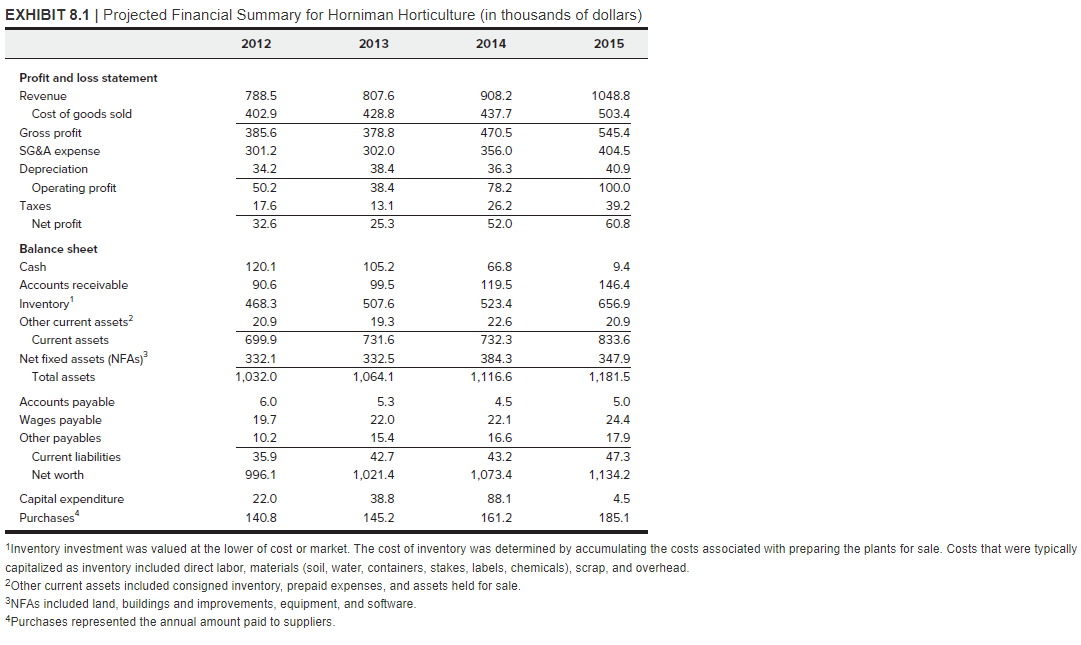

Across almost any dimension of profitability and growth, Bob and Maggie agreed that the business appeared to be strong. They also knew that expectations could change quickly. Increases in interest rates, for example, could substantially slow market demand. The companys margins relied heavily on the hourly wage rate of $10.32, currently required for H2A-certified nonimmigrant foreign agricultural workers. There was some debate within the U.S. Congress about the merits of raising this rate.
Bob was optimistic about the coming year. Given the ongoing strength of the local economy, he expected to have plenty of demand to continue to grow the business. Because much of the inventory took two to five years to mature sufficiently to sell, his top-line expansion efforts had been in the works for some time. Bob was sure that 2016 would be a banner year, with expected revenue hitting a record 30% growth rate. In addition, he looked forward to ensuring long-term-growth opportunities with the expected closing next month on a neighboring 12-acre parcel of farmland.4 But for now, it was Christmas Eve, and Bob was looking forward to taking off work for the entire week. He would enjoy spending time with Maggie and the boys. They had much to celebrate for 2015 and much to look forward to in 2016.
CASE 9
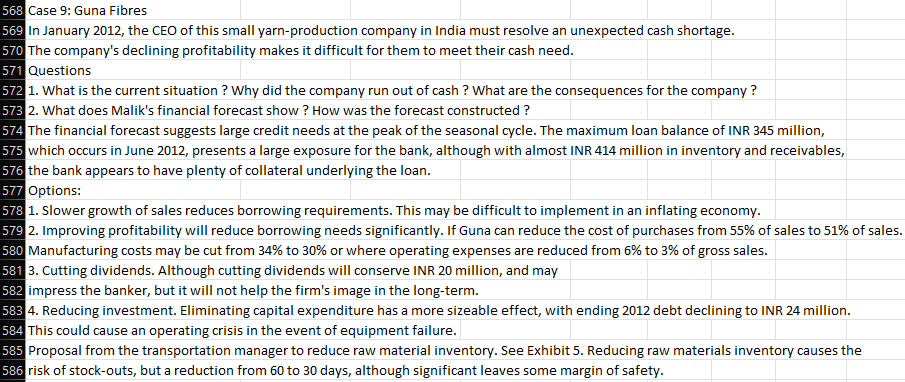
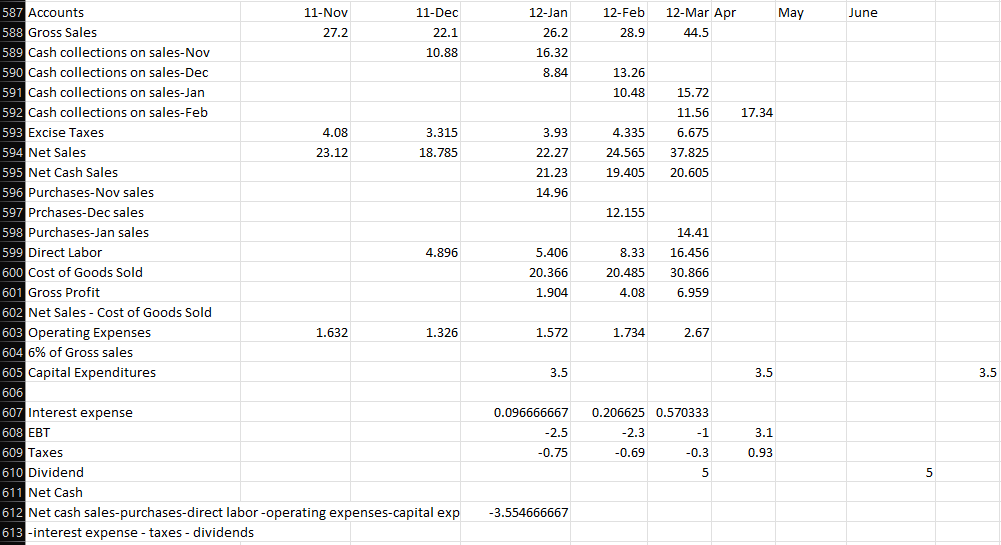
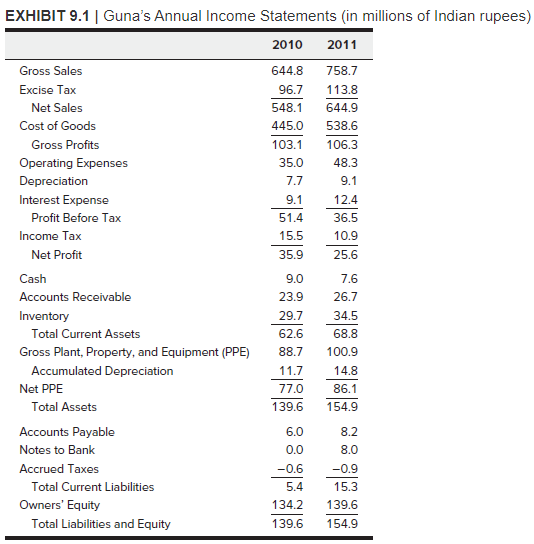
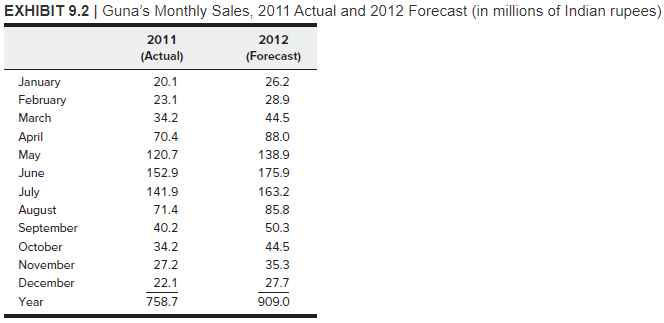
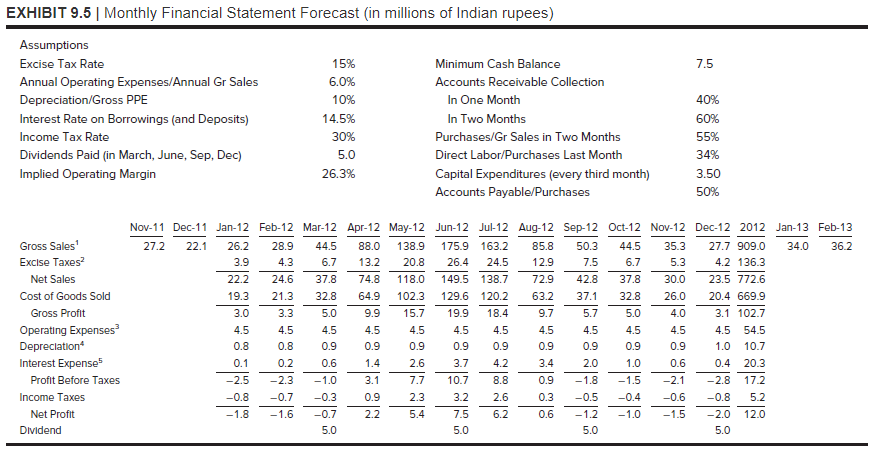
550 Questions 551 1. What are the strengths of this business ? What are its weaknesses? 552 2. Compute the cash cycle and view the operating cash flow ? Do you have concerns about these figures ? 553 Question 3 554 Do you agree with Maggie's accounts payable policy? 555 The discount achieved is 2%. That applies to 20 days of financing. 0.36 The annualized savings is a pretax return of 36.5%. Foregoing the discount cannot be justified in comparison to bank borrowing. Decision: Borrow from the bank. Question 4 What is the problem ? 562 Growth requires an increase in cash flows, which have not been forthcoming. 563 Sustainable growth Return on capital * Level of Growth*Retention Net profit/total capital * total capitalet worth * fraction of profits retained in business net profitet worth * retention 2015 figures 0.053606066 5.40% growth with external funding boost profitability Answer questions on Case 8, Horniman Horticulture, listed in the f41201.4 excel file in Module 3, line 551. Q 1 is a narrative question. Q2 Compute the cash conversion cycle Average inventory period +Accounts receivable period - Accounts payable period. See Exhibit 8.2 This is the number of days to receive cash from accounts receivable collections, and sale of unsold goods. Operating cash flow = EBIT += depreciation taxes. See Exhibit 8.1. Write a few sentences on concerns about these figures. Q 3. Evaluate the discount for early payment given to customers to speed up collection of accounts receivable. Does 2% seem alright ? Why ? Q4. I've listed 5.4% as sustainable growth. Write a few sentences evaluating this amount. Is it realistic ? Create a cash budget for Guna Fibres (Case 9). IInventory investment was valued at the lower of cost or market. Ine cost of inventory was determined by accumulating the costs associated with preparing the plants for sale. Costs that were typically capitalized as inventory included direct labor, materials (soil, water, containers, stakes, labels, chemicals), scrap, and overhead. 2Other current assets included consigned inventory, prepaid expenses, and assets held for sale. "NFAs included land, buildings and improvements, equipment, and software. 4 Purchases represented the annual amount paid to suppliers. EXHIBIT 8.2 | Financial Ratio Analysis and Benchmarkins 1 Benchmark figures were based on 2014 financial ratios of publicly traded horticultural producers. Case 9: Guna Fibres In January 2012, the CEO of this small yarn-production company in India must resolve an unexpected cash shortage. The company's declining profitability makes it difficult for them to meet their cash need. Questions 1. What is the current situation? Why did the company run out of cash? What are the consequences for the company? 2. What does Malik's financial forecast show ? How was the forecast constructed? The financial forecast suggests large credit needs at the peak of the seasonal cycle. The maximum loan balance of INR 345 million, which occurs in June 2012, presents a large exposure for the bank, although with almost INR 414 million in inventory and receivables, the bank appears to have plenty of collateral underlying the loan. Options: 1. Slower growth of sales reduces borrowing requirements. This may be difficult to implement in an inflating economy. 2. Improving profitability will reduce borrowing needs significantly. If Guna can reduce the cost of purchases from 55% of sales to 51% of sales Manufacturing costs may be cut from 34% to 30% or where operating expenses are reduced from 6% to 3% of gross sales. 3. Cutting dividends. Although cutting dividends will conserve INR 20 million, and may impress the banker, but it will not help the firm's image in the long-term. 4. Reducing investment. Eliminating capital expenditure has a more sizeable effect, with ending 2012 debt declining to INR 24 million. This could cause an operating crisis in the event of equipment failure. Proposal from the transportation manager to reduce raw material inventory. See Exhibit 5. Reducing raw materials inventory causes the risk of stock-outs, but a reduction from 60 to 30 days, although significant leaves some margin of safety. + ons of Indian rupees) EXHIBIT 9.2 | Guna's Monthly Sales, 2011 Actual and 2012 Forecast (in millions of Indian rupees) \begin{tabular}{lcc} \hline & 2011(Actual) & 2012(Forecast) \\ \hline January & 20.1 & 26.2 \\ February & 23.1 & 28.9 \\ March & 34.2 & 44.5 \\ April & 70.4 & 88.0 \\ May & 120.7 & 138.9 \\ June & 152.9 & 175.9 \\ July & 141.9 & 163.2 \\ August & 71.4 & 85.8 \\ September & 40.2 & 50.3 \\ October & 34.2 & 44.5 \\ November & 27.2 & 35.3 \\ December & 22.1 & 27.7 \\ Year & 758.7 & 909.0 \\ \hline \end{tabular} EXHIBIT 9.5 | Monthly Financial Statement Forecast (in millions of Indian rupees) Assumptions ExciseTaxRateAnnualOperatingExpenses/AnnualGrSalesDepreciation/GrossPPEInterestRateonBorrowings(andDeposits)IncomeTaxRateDividendsPaid(inMarch,June,Sep,Dec)ImpliedOperatingMargin15%6.0%10%14.5%30%5.026.3%MinimumCashBalanceAccountsReceivableCollectionInOneMonthInTwoMonthsPurchases/GrSalesinTwoMonthsDirectLabor/PurchasesLastMonthCapitalExpenditures(everythirdmonth)AccountsPayable/Purchases 550 Questions 551 1. What are the strengths of this business ? What are its weaknesses? 552 2. Compute the cash cycle and view the operating cash flow ? Do you have concerns about these figures ? 553 Question 3 554 Do you agree with Maggie's accounts payable policy? 555 The discount achieved is 2%. That applies to 20 days of financing. 0.36 The annualized savings is a pretax return of 36.5%. Foregoing the discount cannot be justified in comparison to bank borrowing. Decision: Borrow from the bank. Question 4 What is the problem ? 562 Growth requires an increase in cash flows, which have not been forthcoming. 563 Sustainable growth Return on capital * Level of Growth*Retention Net profit/total capital * total capitalet worth * fraction of profits retained in business net profitet worth * retention 2015 figures 0.053606066 5.40% growth with external funding boost profitability Answer questions on Case 8, Horniman Horticulture, listed in the f41201.4 excel file in Module 3, line 551. Q 1 is a narrative question. Q2 Compute the cash conversion cycle Average inventory period +Accounts receivable period - Accounts payable period. See Exhibit 8.2 This is the number of days to receive cash from accounts receivable collections, and sale of unsold goods. Operating cash flow = EBIT += depreciation taxes. See Exhibit 8.1. Write a few sentences on concerns about these figures. Q 3. Evaluate the discount for early payment given to customers to speed up collection of accounts receivable. Does 2% seem alright ? Why ? Q4. I've listed 5.4% as sustainable growth. Write a few sentences evaluating this amount. Is it realistic ? Create a cash budget for Guna Fibres (Case 9). IInventory investment was valued at the lower of cost or market. Ine cost of inventory was determined by accumulating the costs associated with preparing the plants for sale. Costs that were typically capitalized as inventory included direct labor, materials (soil, water, containers, stakes, labels, chemicals), scrap, and overhead. 2Other current assets included consigned inventory, prepaid expenses, and assets held for sale. "NFAs included land, buildings and improvements, equipment, and software. 4 Purchases represented the annual amount paid to suppliers. EXHIBIT 8.2 | Financial Ratio Analysis and Benchmarkins 1 Benchmark figures were based on 2014 financial ratios of publicly traded horticultural producers. Case 9: Guna Fibres In January 2012, the CEO of this small yarn-production company in India must resolve an unexpected cash shortage. The company's declining profitability makes it difficult for them to meet their cash need. Questions 1. What is the current situation? Why did the company run out of cash? What are the consequences for the company? 2. What does Malik's financial forecast show ? How was the forecast constructed? The financial forecast suggests large credit needs at the peak of the seasonal cycle. The maximum loan balance of INR 345 million, which occurs in June 2012, presents a large exposure for the bank, although with almost INR 414 million in inventory and receivables, the bank appears to have plenty of collateral underlying the loan. Options: 1. Slower growth of sales reduces borrowing requirements. This may be difficult to implement in an inflating economy. 2. Improving profitability will reduce borrowing needs significantly. If Guna can reduce the cost of purchases from 55% of sales to 51% of sales Manufacturing costs may be cut from 34% to 30% or where operating expenses are reduced from 6% to 3% of gross sales. 3. Cutting dividends. Although cutting dividends will conserve INR 20 million, and may impress the banker, but it will not help the firm's image in the long-term. 4. Reducing investment. Eliminating capital expenditure has a more sizeable effect, with ending 2012 debt declining to INR 24 million. This could cause an operating crisis in the event of equipment failure. Proposal from the transportation manager to reduce raw material inventory. See Exhibit 5. Reducing raw materials inventory causes the risk of stock-outs, but a reduction from 60 to 30 days, although significant leaves some margin of safety. + ons of Indian rupees) EXHIBIT 9.2 | Guna's Monthly Sales, 2011 Actual and 2012 Forecast (in millions of Indian rupees) \begin{tabular}{lcc} \hline & 2011(Actual) & 2012(Forecast) \\ \hline January & 20.1 & 26.2 \\ February & 23.1 & 28.9 \\ March & 34.2 & 44.5 \\ April & 70.4 & 88.0 \\ May & 120.7 & 138.9 \\ June & 152.9 & 175.9 \\ July & 141.9 & 163.2 \\ August & 71.4 & 85.8 \\ September & 40.2 & 50.3 \\ October & 34.2 & 44.5 \\ November & 27.2 & 35.3 \\ December & 22.1 & 27.7 \\ Year & 758.7 & 909.0 \\ \hline \end{tabular} EXHIBIT 9.5 | Monthly Financial Statement Forecast (in millions of Indian rupees) Assumptions ExciseTaxRateAnnualOperatingExpenses/AnnualGrSalesDepreciation/GrossPPEInterestRateonBorrowings(andDeposits)IncomeTaxRateDividendsPaid(inMarch,June,Sep,Dec)ImpliedOperatingMargin15%6.0%10%14.5%30%5.026.3%MinimumCashBalanceAccountsReceivableCollectionInOneMonthInTwoMonthsPurchases/GrSalesinTwoMonthsDirectLabor/PurchasesLastMonthCapitalExpenditures(everythirdmonth)AccountsPayable/Purchases















